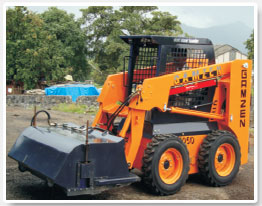Skid steer loaders have revolutionized the construction industry with their versatility and efficiency. These compact machines are designed to maneuver in tight spaces, making them ideal for a wide range of applications. Throughout the years, skid steer loaders have undergone significant advancements in design and technology, resulting in more powerful and efficient machines. In this article, I will explore the evolution of skid steer loaders, their key features, the impact they have had on the construction industry, and the future trends in skid steer loader design.
Historical development of skid steer loaders
The history of skid steer loaders dates back to the 1950s when brothers Cyril and Louis Keller invented the first skid-steer loader. Their invention was primarily driven by the need for a compact and maneuverable machine that could assist with various tasks on their farm. The Keller brothers’ machine utilized a unique design that enabled it to turn within its own footprint. This innovative design became the foundation for future skid steer loaders.
Technological advancements in skid steer design
Over the years, skid steer loaders have seen significant technological advancements that have improved their performance and capabilities. One key development has been the increase in power and engine efficiency. Modern skid steer loaders are equipped with powerful engines that deliver higher horsepower, allowing for increased productivity and the ability to handle heavier loads.
Another important aspect of skid steer design is the hydraulic system. Hydraulic systems play a crucial role in powering the attachments and providing the necessary force for lifting and digging. Advances in hydraulic technology have resulted in more precise and efficient control of the machine, improving overall performance.
Key Features of Modern Skid Steer Loaders
Power and performance capabilities
Modern skid steer loaders come with a wide range of power options, allowing operators to choose a machine that best suits their needs. The horsepower rating determines the lifting and digging capacity of the machine. Skid steer loaders typically range from 20 to 100 horsepower, with the higher horsepower models being capable of tackling heavier-duty tasks.
Versatility and adaptability for various applications
One of the defining features of skid steer loaders is their versatility. These machines can be equipped with a variety of attachments, such as buckets, augers, trenchers, and hydraulic hammers, to perform different tasks. This adaptability makes skid steer loaders invaluable in construction, landscaping, agriculture, and many other industries.
Comparison of skid steer models from different manufacturers
When choosing a skid steer loader, it is essential to consider the different models available from various manufacturers. Each model has its own specifications, such as rated operating capacity, operating weight, and horsepower. It is important to analyze these specifications and compare them to your specific requirements to ensure you select the right machine for the job.
Impact of Skid Steer Loaders in the Construction Industry
Efficiency and productivity improvements
Skid steer loaders have had a significant impact on the construction industry by improving efficiency and productivity. Their compact size allows them to access tight spaces that larger machines cannot reach. This versatility enables operators to complete tasks quickly and more efficiently, reducing the time required for a project and increasing overall productivity.
Cost-effectiveness and labor savings
The use of skid steer loaders can lead to substantial cost savings in the construction industry. Their versatility eliminates the need for multiple machines, reducing equipment costs.
Additionally, their compact size requires less space for storage, resulting in lower operational expenses. Skid steer loaders also minimize the need for manual labor, saving companies significant costs associated with hiring and training additional personnel.
Future Trends in Skid Steer Loader Design
Integration of advanced automation and control systems
The future of skid steer loader design is likely to be influenced by advanced automation and control systems. These systems will enhance productivity and safety by enabling operators to remotely control the machine or automate certain tasks.
For example, autonomous skid steer loaders could be programmed to perform repetitive tasks, freeing up operators to focus on more complex activities.
Environmental considerations and sustainable design
As the construction industry becomes increasingly focused on sustainable practices, skid steer loader manufacturers are likely to incorporate environmentally friendly features into their designs. This could include the use of electric or hybrid power systems, reducing emissions and noise pollution.
Additionally, skid steer loaders may be designed to optimize fuel efficiency and minimize waste.
Predictions for the future of skid steer technology
Looking ahead, it is expected that skid steer loaders will continue to evolve with advancements in technology. These machines are likely to become smarter, with improved sensors and telematics capabilities. This will enable better monitoring of machine performance and provide valuable data for maintenance and operational optimization.
FAQs
- What is a skid steer?
Answer: A skid steer is a compact, engine-powered machine that is equipped with lift arms and a variety of attachments. It is designed to perform a wide range of tasks, such as digging, lifting, and moving materials, in various industries. - What are the main characteristics of skid steer design?
Answer:Skid steer loaders are characterized by their compact size, maneuverability, and ability to turn within their own footprint. They are typically equipped with four wheels and have variable speed control. The lift arms and attachment interface allow for quick and easy attachment changes. - How has skid steer design evolved over time?
Answer: Skid steer design has evolved significantly since its invention in the 1950s. Today’s skid steer loaders offer increased power, improved hydraulic systems, and enhanced control features. Manufacturers continue to innovate, incorporating advanced technologies to improve efficiency, productivity, and operator comfort. - What are the common applications of skid steers?
Answer: Skid steer loaders are used in a wide range of industries and applications. They are commonly used in construction for tasks such as excavation, grading, and material handling. Skid steers are also utilized in landscaping, agriculture, forestry, snow removal, and many other sectors where compact and versatile machinery is required.
In conclusion, skid steer loaders have come a long way since their humble beginnings. The evolution of skid steer design has resulted in powerful, versatile, and efficient machines that have had a profound impact on the construction industry. As technology continues to advance, skid steer loaders are likely to become even smarter and more environmentally friendly. These machines will continue to play a crucial role in various industries, helping operators accomplish more and tackle the most challenging jobs with ease.

